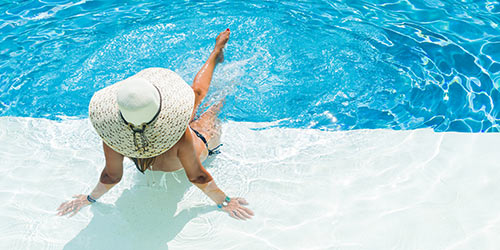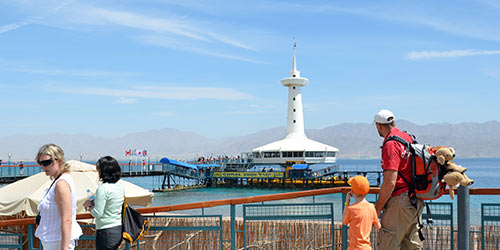Eilat's geographical location, where the four Red Sea nations meet, means that the masses of tourists visiting Israel's vacation capital can enjoy a border-crossing holiday in the Middle East. There are several ways to cross the border from Eilat to Egypt and Jordan and back, and we recommend including some tours and days trips to Israel's neighbors during a stay in town.
A vacation in the Middle East in general and at the Red Sea in particular is a great experience. Many visitors think of Eilat as a wonderful base for day-trips to the Red Sea and the Israel-Egypt-Jordan triangle. Aqaba, arguably Jordan's premier vacation city, is easily accessed from Eilat via the Yitzhak Rabin Border Crossing. The same is true for the Egyptian vacation paradise of Taba, reached via the Menachem Begin Border Crossing. Both crossings are merely a 10-min drive from the city. Many prefer to stay overnight in the city's hotels, leave each morning for tours across the border, and come back to the city for a delightful dinner and a good night's sleep. For others, Eilat is one stop of many on a trip around the Red Sea that includes stays and overnights in Saudi Arabia, Jordan, and Egypt too.
The border crossing to Egypt allows visitors to vacation in Sinai and enjoy the peninsula's famous beaches, as well as visit fantastic attractions such as Saint Catherine's Monastery at Mt. Sinai; the Blue Lagoon, one of the world's most beautiful scuba diving sites; and Cairo, the Egyptian capital and one of the most important cities of global cultural value with the Giza pyramid complex right there. Many tourists who choose to stay in Eilat cross the border by foot every night to gamble at the casinos in Taba, as Israel prohibits casino operations. Crossing on foot takes only about 15 min mid-week, but on weekends and during Israeli holidays, crossing from Israel to Egypt is liable to take much longer due to heavy foot traffic.
TABA Border Crossing
The Menachem Begin Border Crossing to Taba is located at Eilat's southernmost point, a 10-min ride from the city center. Taba Terminal can be reached by taxi or by the Egged bus line 15, which departs from Eilat’s Central Bus Station every half hour (ticket price: NIS 4.20). At the crossing, it is necessary to pay NIS 107 on the Israeli side plus another E£ 400 (~NIS 80) on the Egyptian side.
Click here for more information on the Menachem Begin Border Crossing
Here are some suggested day trips to Egypt:
The Blue Hole , also known as the Blue Lagoon, is one of the most popular diving spots in the Red Sea. The resort next to it is located 150 km south of Eilat in the Sinai Peninsula. The hole itself is a vertical, 140-m deep hollow inside a coral reef. Between the hole and the open sea stands a vertical wall ending in an underwater arch 56 m below the surface. The site is a paradise for Red Sea divers and snorkeling enthusiasts.
Castle Zaman is one of the most beautiful holiday sites at the Red Sea. Castle Zaman is a castle built on a mountainside across from the turquoise waters of the Red Sea, featuring a restaurant serving a limited menu of slow-cooked items – at least three hours per dish. The site features a drinks bar, a spa, a sauna, a private primeval beach, a large pool, and a tour in the course of which it's possible to get an impression of local art and handicrafts from different eras of Egyptian culture.
Saint Catherine's is the oldest Eastern Orthodox monastery in consecutive operation in the world. Pilgrims and tourists from all over the world make the pilgrimage to the monastery to pray there and derive inspiration from the largest collection of works of art in the world second only to the Vatican collection in Rome. Many travelers opt to visit the monastery and then to travel to the foot of Jabel Musa, one of the most beautiful walking trails in the region, where it is possible to observe the thrilling sight of the Edom Mountains.
Rabin Border Crossing
The land border between Israel and Jordan is busy. Crossing over allows visitors to tour Jordan, which provides access to other Middle East countries, such as Saudi Arabia, whose border with Jordan is clearly visible from Eilat's beaches. The Yitzhak Rabin Arava Border Crossing, the land border between Israel and Jordan, is located about 3 km north of Eilat. The border crossing fee is NIS 107 on the Israeli side and US $15 on the Jordanian side each way. Most tourists choosing to visit Jordan via this border do so to visit Petra, one of the world’s wonders, located a 2-hr drive from the border. Busses and taxis going there leave right from the border.
Click here for more information on the Yitzhak Rabin Arava Border Crossing
Here are some suggested tours of Jordan:
Petra is a UNESCO World Heritage Site located some 100 km from Eilat. The site has many nicknames, including the "Red Rock" and the "Pink City," because of the color of the rocks. In 2007, the site was selected as one of the "Seven New Wonders of the World." Petra is an ancient Nabatean city, full of buildings and burial palaces carved right out of the sandstone of the Edom Mountains. Tourists from all over the world come to Petra to tour the enormous canyon and see the manmade rock formations, palaces, sculptures, engraved embossings on the walls, and more. Petra is one of the most beautiful and important historic sites in the world, from a religious and archeological point of view. Tours of Petra regularly depart from Eilat hotels and cover the border crossing to Jordan and transportation to Petra and back.
Wadi Rum is a spectacular archeological site that was named a UNESCO World Heritage Site in 2011 and is one of the two most popular tourist destination in Jordan together with Petra. The wadi is located some 70 km from Eilat in southwestern Jordan, and is also called the Valley of the Moon because of its striated surface, which resembles the surface of the moon. The wadi is characterized by enchanted desert landscapes of the colorful sandstone and granite of Mt. Rum located at the edge of the wadi. The walking trails in the wadi are captivating. Some are narrow and windy and include natural stone arches, caves, high cliffs, and ancient archeological findings, such as tens of thousands of petroglyphs and rock inscriptions, ancient alphabetic writing, and descriptions of desert agriculture in antiquity.














